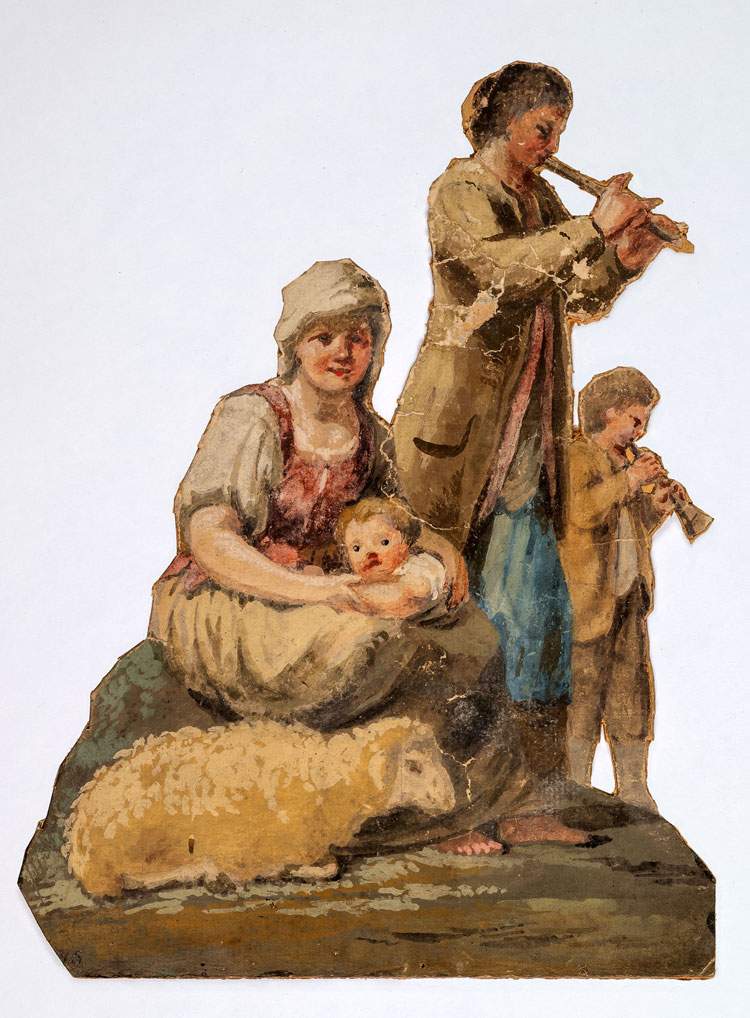Milan, on display the rediscovered and unpublished 18th century nativity scene by Francesco Londonio
A large eighteenth-century nativity scene, composed of sixty characters painted in tempera on paper or shaped cardboard, created by Francesco Londonio (Milan, 1723 - 1783), one of the leading Milanese artists of the eighteenth century. It is a new acquisition of the Carlo Maria Martini Diocesan Museum in Milan and is on display from December 14, 2018, to January 10, 2019, at Palazzo Pirelli, home of the Regional Council of Lombardy. The nativity scene, acquired thanks to a donation from Anna Maria Bagatti Valsecchi, comes from the Cavazzi della Somaglia collection in the Villa Gernetto in Lesmo, and is probably one of the few eighteenth-century Lombard cribs of this type.
The work was originally intended to be set up during the Christmas season in a hall of Villa del Gernetto in Lesmo, Brianza, purchased in 1772 by Count Giacomo Mellerio (1711 - 1782), at which Londonio used to spend long holiday periods. During the nineteenth century, when the importance and rarity of the complex became clear, Mellerio’s heirs had the silhouettes mounted within oval or rectangular frames that were used as a permanent decoration for the halls of the Brianza residence. The Gernetto Nativity, known to critics, is mentioned in historiography and in all publications dedicated to Francesco Londonio and the nativity scene in Lombardy. The layout, curated by architect Alessandro Colombo, will give reason for the different nuclei, recreating with great suggestion the arrangement of the figures.
An initial, minimal conservative intervention has also made it possible to present the unseen crib today: however, the work needs more complex restoration work, for which it will be necessary to raise funds. For this reason, the Regional Council intends to associate itself with this exhibition event with the recovery, promotion and enhancement of this significant work initiated by the Diocesan Museum of Milan, offering the visibility of Italy’s largest regional assembly. Alongside Londonio’s nativity scene, a terracotta high-relief depicting a Nativity with Angels probably by a 17th-century northern Italian sculptor, also from the Diocesan Museum in Milan, is also on display in the foyer of the ground floor of the Palazzo Pirelli.
Nothing is known about the history of this work, which came to the Museum from a private collection: recent restoration (2013) revealed two previous interventions, which occurred at an unspecified time. The panel consists of three pieces individually worked and fired and then assembled with terracotta sealings and an iron staple. The scene is set in a fragmentary hut supported by imposing ruined columns that are lost in the clouds, following a pattern widely used in northern Italy. The Holy Family, on the left, appears almost in the background compared to the adoring angels and cherubs that animate the scene.
“The nativity scene,” said Regional Council President Alessandro Fermi, “is an Italian tradition and an element of our popular culture that condenses the meanings that go along with the birth of Jesus. But it is also a representation of the values of Christian humanism: the sacredness of the life that is born, the family, the equal dignity of the humble in the shepherds who first encounter Jesus, and attention to creation. In the nativity scene there is also attention to the diversity of other cultures, think of the Magi who came from the East. These are universal values that all believers and non-believers alike can make their own. In this spirit we host these beautiful works of art that I am sure will captivate guests visiting our venue, offering them a pause for reflection and beauty.”
The nativity scene can be viewed Monday through Thursday from 9:30 a.m. to 4:45 p.m. and Fridays from 9:30 a.m. to 1 p.m. Free admission.
Pictured: Francesco Londonio, Nativity scene, Young mother with child and two piper with sheep (30 x 22.9 cm)
 |
| Milan, on display the rediscovered and unpublished 18th century nativity scene by Francesco Londonio |
Warning: the translation into English of the original Italian article was created using automatic tools. We undertake to review all articles, but we do not guarantee the total absence of inaccuracies in the translation due to the program. You can find the original by clicking on the ITA button. If you find any mistake,please contact us.




























